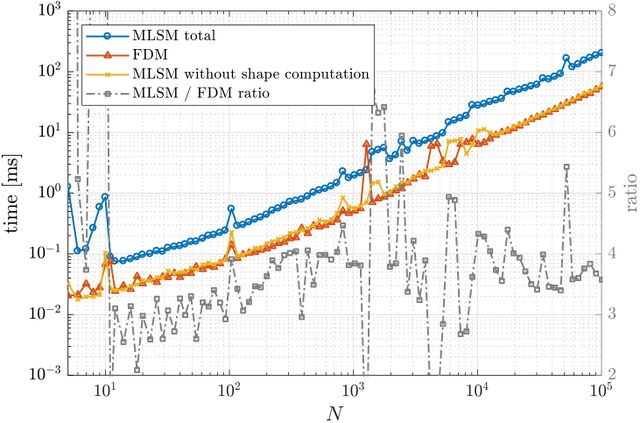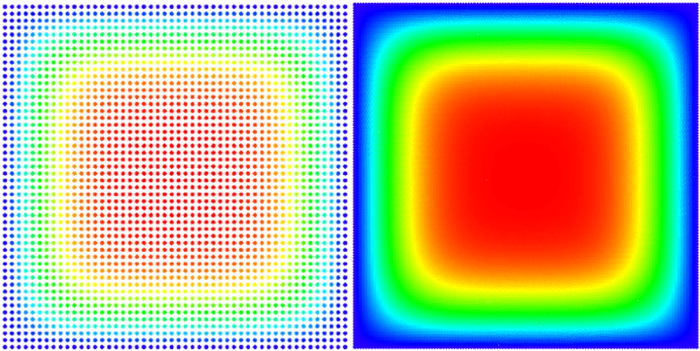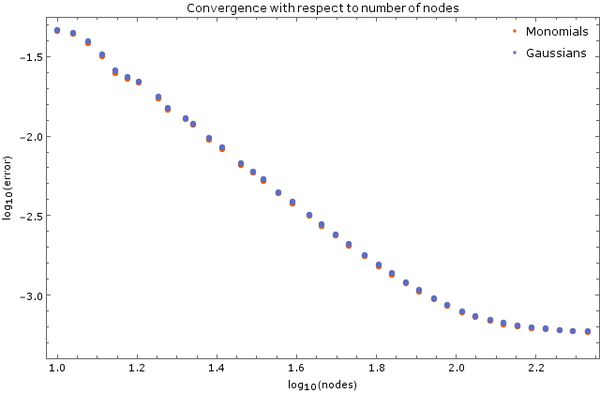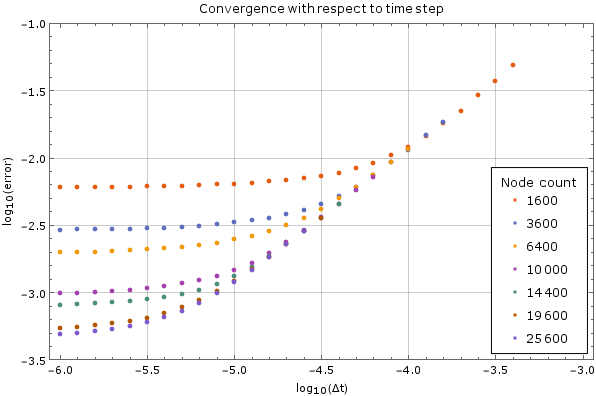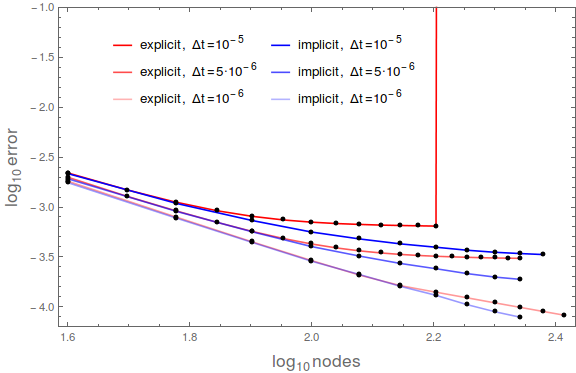Difference between revisions of "Convection Diffusion equation"
(→Time dependent 2D case) |
(→Time dependent 2D case) |
||
| Line 67: | Line 67: | ||
Temperature contour polot after $t = 0.05$ and convergence regarding the number of nodes | Temperature contour polot after $t = 0.05$ and convergence regarding the number of nodes | ||
| − | [[File:square_heat.png|700 px]][[File: | + | [[File:square_heat.png|700 px]][[File:node_convergence_5.png|600 px]] |
| − | |||
We tested the method with a fixed time step of $ \Delta t = 1\cdot 10^{-5}$ | We tested the method with a fixed time step of $ \Delta t = 1\cdot 10^{-5}$ | ||
on a unit square ($a = 1$). Monomial basis of $6$ monomials was used and $12$ | on a unit square ($a = 1$). Monomial basis of $6$ monomials was used and $12$ | ||
| − | closest nodes counted as support for each node. After more than $250$ nodes of | + | closest nodes counted as support for each node in one setup and in |
| + | another 5 Guassians on 5 suport nodes. After more than $250$ nodes of | ||
discretization in each dimension the method diverges, which is expected. The | discretization in each dimension the method diverges, which is expected. The | ||
stability criterion for diffusion equation in two dimensions is $\Delta t \leq | stability criterion for diffusion equation in two dimensions is $\Delta t \leq | ||
| Line 80: | Line 80: | ||
so our method is stable within the expected region. | so our method is stable within the expected region. | ||
| − | |||
| − | |||
| − | |||
| − | |||
| − | |||
| − | |||
| − | |||
| − | |||
| − | |||
| − | |||
| − | |||
Figure 4 shows convergence of 1/4 of the whole solution with Dirichlet boundary conditions (Fig. 1). The nodes were spanning the area $[0, a/2]^2$. As expected, higher number of nodes yields lower max error up to some maximal number of nodes. The latter is lower for explicit than for implicit method. | Figure 4 shows convergence of 1/4 of the whole solution with Dirichlet boundary conditions (Fig. 1). The nodes were spanning the area $[0, a/2]^2$. As expected, higher number of nodes yields lower max error up to some maximal number of nodes. The latter is lower for explicit than for implicit method. | ||
| Line 98: | Line 87: | ||
[[File:timestep_convergence.png|thumb|upright=2|center|<caption>Convergence with respect to different timesteps</caption>]] | [[File:timestep_convergence.png|thumb|upright=2|center|<caption>Convergence with respect to different timesteps</caption>]] | ||
</figure> | </figure> | ||
| + | |||
| + | Next, we compare implicit and explicit solution | ||
| + | |||
| + | [[File:explicit_implicit_diffusion_comparison_ver2.png|thumb|upright=2|center|<caption>Convergence with respect to number of nodes for explicit and implicit mixed boundary condition (Neumann is enforced in two different ways).</caption>]] | ||
| + | |||
| + | |||
We tested the method on a fixed node count with different time steps on the same | We tested the method on a fixed node count with different time steps on the same | ||
Revision as of 11:32, 24 February 2018
Before moving to more complex numerical examples, preliminary tests are done on a case with a known closed form solution. As in all the previous examples, we use the diffusion equation for a test case. The main purpose of this section is basic evaluation of mesh based against meshless methods, as well as strong form against weak form methods. More specific analyses and performance tests are presented in Chapter \ref{cases}.
\section{Diffusion equation}
\index{Diffusion equation} A 2D diffusion equation in its dimensionless form is considered: \begin{align} %??? brezdimenzijska oblika nima c \frac{\partial u}{\partial t} - \nabla^2u = q, & \qquad (x, y)\in \Omega, \label{eq.diffu}\\ % \frac{\partial u(x,y,t)}{\partial t} = \nabla^2 u(x,y,t), & \qquad (x, y)\in \Omega, \label{eq.diffusion}\\ u(x,y,t) = \overline{u}(x,y,t), & \qquad (x,y) \in \Gamma_D,\label{eq.bc_diffu}\\ u(x,y,t),_n = \overline{g}(x,y,t), & \qquad (x,y) \in \Gamma_N, \label{eq.mixed.bc_diffu}\\ u(x,y,t) = u_0, & \qquad t=0,\label{eq.ic_diffu} \end{align} where $(x,y)$ are spatial coordinates, $t$ is time, $u(x, y, t)$ is the unknown solution, $ \Omega$, and $ \Gamma_D$ and $ \Gamma_N$ are the global domain with Dirichlet boundary and Neumann boundary, $\overline{u}$ and $\overline{g}$ are the prescribed Dirichlet and Neumann boundary values and $u(x,y,0)=u_0$ is the known initial condition.
Boring 1D case
First, a simple one dimensional case is tackled to assess basic properties of presented solution method. Consider the problem \begin{align} u''(x) &= \sin(x), \quad x \in (0, 1) \nonumber \\ u(0) &= 0 \label{eq:neu1d} \\ u'(1) &= 0 \nonumber \end{align} with analytical solution \begin{equation} u(x) = x \cos 1 - \sin x. \end{equation} We solve the problem with MLSM using 3 support nodes and 3 monomials $\{1, x, x^2\}$ as basis functions on a regularly distributed nodes. This setup of MLSM is theoretically equivalent to the Finite Difference Method (FDM) and therefore it is worth implementing also standard FDM to compare results and execution times. The error between the actual solution $u$ and the approximate solution $\hat{u}$ is measured in $\ell_\infty$ norm, \begin{equation} \|u - \hat{u}\|_{\ell_\infty} = \max_{x\in X} | u(x) - \hat{u}(x)|, \label{eq:linf-err} \end{equation} where $X$ is the set of all points in the domain. The problem can be solved with below code.
1 for (int i : domain.internal()) {
2 op.lap(M, i, 1.0); // Equation.
3 rhs(i) = std::sin(domain.positions[i][0]);
4 }
5 op.value(M, left, 1.0); // Left BC.
6 op.neumann(M, right, {1}, 1.0); // Right BC.
7 VectorXd solution = M.lu().solve(rhs);
As expected, MLSM is slower due to computation of shape functions, which are known in advance in FDM. However, counting that as part of the preprocessing and measuring only the part equivalent to FDM, it can be seen that the execution times for FDM and MLSM are the same for all practical purposes.
Time dependent 2D case
We solved the equation on a square $\Omega = [0, a] \times [0, a]$ with Dirichlet boundary conditions $ \left. u\right|_{\partial \Omega} = 0 $ and initial state $ u(t = 0) = 1$. An analytical solution for this domain is known \begin{equation} u(\vec{p}, t) = \sum_{\substack{n=1 \\ n \text{ odd}}}^\infty\sum_{\substack{m=1 \\ m \text{ odd}}}^\infty \frac{1}{\pi^2} \frac{16 a^2}{nm} \sin\left(\frac{\pi n}{a}p_x\right) \sin\left(\frac{\pi m}{a}p_y\right) e^{-\frac{\pi^2 (n^2+m^2)}{a^2}t} \end{equation}
Temperature contour polot after $t = 0.05$ and convergence regarding the number of nodes
We tested the method with a fixed time step of $ \Delta t = 1\cdot 10^{-5}$ on a unit square ($a = 1$). Monomial basis of $6$ monomials was used and $12$ closest nodes counted as support for each node in one setup and in another 5 Guassians on 5 suport nodes. After more than $250$ nodes of discretization in each dimension the method diverges, which is expected. The stability criterion for diffusion equation in two dimensions is $\Delta t \leq \frac{1}{4} \Delta x^2$, where $\Delta x$ is the spatial discretization step in one dimension. In our case, at $250$ nodes per side, the right hand side yields $\frac{1}{4}\cdot\frac{1}{250}\cdot\frac{1}{250} = 4\times 10^{-6}$, so our method is stable within the expected region.
Figure 4 shows convergence of 1/4 of the whole solution with Dirichlet boundary conditions (Fig. 1). The nodes were spanning the area $[0, a/2]^2$. As expected, higher number of nodes yields lower max error up to some maximal number of nodes. The latter is lower for explicit than for implicit method.
Convergence with respect to number of time steps
Next, we compare implicit and explicit solution
We tested the method on a fixed node count with different time steps on the same domain as above. Results are on Figure 1. For large time steps the method diverges, but once it starts converging the precision increases steadily as the time step decreases, until it hits its lower limit. This behaviour is expected. The error was calculated against the analytical solution above after $0.005$ units of time have passed. A monomial basis up to order $2$ inclusive ($m = 6$) was used and the support size was $n = 12$.

